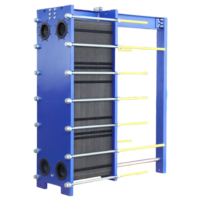The Different Types of Plate Designs in Plate Heat Exchangers
Plate heat exchangers (PHEs) come in different designs, each optimized for particular applications and operating conditions. The diverse types of plate plans utilized in plate heat exchangers incorporate:
Chevron or Herringbone Pattern:
Chevron plates are the foremost common sort of plate plan utilized in plate heat exchangers. These plates highlight a chevron or herringbone pattern, which makes turbulence within the flow channels and promotes productive heat exchange between liquids. Chevron plates are flexible and reasonable for a wide range of applications.
Wide Gap Plates:
Wide crevice plates include larger gaps between adjoining plates compared to conventional chevron plates. These plates are planned for applications including fluids with high consistency or containing suspended solids. The wider gaps permit for simpler passage of thick liquids and reduce the chance of fouling or clogging.
Free Flow Plates:
Free flow plates are characterized by open channels without traditional chevron designs. These plates are utilized for applications including liquids with tall fouling propensities or containing large particulate matter. The absence of chevron patterns minimizes the risk of fouling and allows for easy cleaning and support.
Welded Plate Packs:
Welded plate packs consist of plates that are forever welded together to make a compact unit. These plates are used in applications requiring high-pressure or destructive fluids, where gaskets may not be appropriate. Welded plate packs offer improved basic integrity and reliability compared to gasketed plans.
Dual-Plate Arrangement:
In dual-plate arrangements, sets of plates are stacked in conjunction with rotating stream channels to maximize heat exchange productivity. This plan allows for counter-current stream, where the hot and cold liquids flow in inverse bearings, coming about in ideal temperature differences over the plates and moved forward heat transfer rates.
Multi-Stage Plate Designs:
Multi-stage plate plans comprise of different plate packs organized in arrangement or parallel setups to realize higher warm exchange coefficients or oblige specific process necessities. These plans are utilized in applications where single-stage heat exchangers may not give adequate heat transfer capacity.
Specialty Plate Designs:
Strength plate designs are customized to meet particular application needs, such as high-temperature operation, extraordinary pressure conditions, or stringent sterile requirements. These plates may highlight unique geometries, materials, or surface treatments tailored to the application’s unique challenges.
Each sort of plate plan offers unmistakable preferences and is chosen based on factors such as liquid properties, working conditions, heat transfer requirements, and support considerations. By choosing the suitable plate design, engineers can optimize the execution, proficiency, and reliability of plate heat exchangers for a wide run of industrial, commercial, and residential applications.

